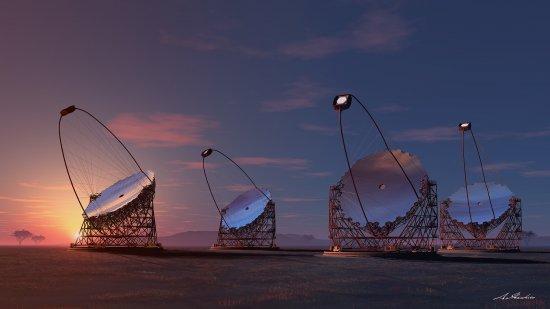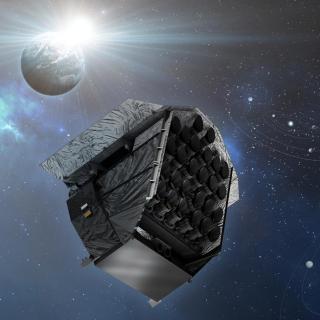The CTA (Cherenkov Telescope Array) Consortium, which met yesterday in Heidelberg, (Germany) with representatives of 13 countries (Argentina, Austria, Brazil, The Czech Republic, France, Germany, Italy, Japan, Poland, South Africa, South Africa, Switzerland, and the United Kingdom) have finally decided to open negotiations with Spain on the possible siting at the Roque de los Muchachos Observatory (ORM) on the Island of La Palma, of its major scientific installation in the northern hemisphere. The array will consist of 100 Cherenkov telescopes for detecting high energy radiation, distributed between the two hemispheres. Of these, some 20 will be in the northern hemisphere.
The Astrophysics Institute of the Canaries (IAC), which runs this observatory, also signed, yesterday, a collaborative agreement with the Institute for Cosmic Ray Research at the University of Tokyo, which represents a large consortium of universities and research institutes which are members of the CTA Consortium, for the installation on La Palma of the 23 m diameter prototype of the Large Telescope of this Cherenkov Telescope Array (CTA-LST).
Evaluations
“We are convinced”, said Rafael Rebolo, Director of the IAC “that if the northern installations of the CTA are finally sited in the Canaries, the project will be a great scientific success thanks to our magnificent skies, and exceptional infrastructure”. He added “There is no doubt that this success will have benefitted greatly from the strong support received from the Ministry of Economy and Competitiveness (MINECO) and from the Government of the Canaries to the Spanish candidacy”.
According to Ramón García López, Principal Investigator for the CTA in the IAC, “Installing the CTA-North at the ORM will increase its capacity by a factor of 10 in the observation of the most violent events in the universe, keeping the observatory at the forefront of astrophysical observations”.
“Yesterday’s decision”, commented Manel Martínez, of the Institute of High Energy Physics (IFAE) in Barcelona and coordinator of the Spanish side of the CTA project, “is a very important step forward for the CTA project because it shows that there is the willingness to build the northern observatory, and it is especially important for the Spanish astronomical community working on gamma-rays, because we are determined to give our branch of science a qualitative boost, thanks to the possibility of having the CTA-North at the ORM”.
Juan Cortina, co-Principal Investigator on the LST commented “The gamma-ray sky is almost unexplored, and it changes from day to day and from hour to hour. With the CTA we will observe stars and galaxies ten times fainter than those with the telescopes which we have at present. I am sure that we will have many surprises”
And about the prototype for the LST Cortina explains “The dimensions of the LST are very big. The diameter of its mirror is 23m and that of the camera used to detect the gamma-rays is 3m. This camera, the most complicated and rapid in the world, will be put together and set working in the IFAE at the end of this year, to be sent to La Palma next summer:”
Cherenkov Telescopes
The CTA is an initiative which is planning the construction of a new generation of Cherenkov Telescopes to study the universe in very high energy gamma-rays. Gamma-rays carry information about the most violent and extreme events in the universe.
The international CTA collaboration is aiming to build two large observatory complexes, in the northern and southern hemispheres. La Palma is one of the candidate sites to house the northern observatory, in competition with the San Pedro Mártir Observatory in Mexico. These are the two sites with the best valuations. At first, five sites were considered, two in Arizona (USA), one in Baja California (México), and two in the Canary Islands. The final decision about the siting of these observatories will be taken at the end of 2015.
The CTA telescopes will come in three sizes. The largest will be the four LST’s, with mirrors of 23m diameter. These LST’s are under design by a team of universities and research institutes, which are proposing to install a prototype at the Roque de Los Muchachos Observatory (ORM), in La Palma, next year. The ORM already houses the working MAGIC telescopes, considered among the best in the world for this range of ultra-high energy.
Además de grupos de Japón, Italia, Francia, Alemania, Brasil, India y Suecia, en los LST trabajan los grupos españoles de la Universidad de Barcelona, el IFAE, el CIEMAT y la Universidad Complutense.
Working on the LST, as well as groups from Japan, Italy, France, Germany, Brazil, Indian and Sweden, are the Spanish groups from the University of Barcelona, the IFAE, the CIEMAT, and the Complutense University of Madrid.
In the CTA collaboration there is participation by groups from the IAC, the ICE, the UAB, and the University of Jaen.
Link to press note from the CTA Consortium: https://portal.cta-observatory.org/Pages/News.aspx



